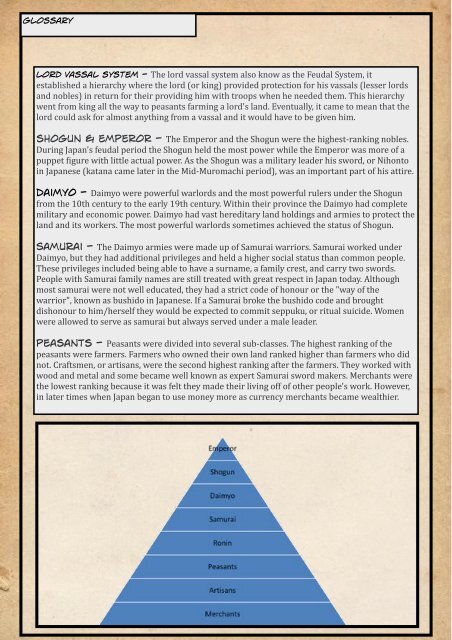You also want an ePaper? Increase the reach of your titles
YUMPU automatically turns print PDFs into web optimized ePapers that Google loves.
Glossary<br />
lord vassal system - <strong>The</strong> lord vassal system also know as the Feudal System, it <br />
established a hierarchy where the lord (or king) provided protection for his vassals (lesser lords <br />
and nobles) in return for their providing him with troops when he needed them. This hierarchy <br />
went from king all the way to peasants farming a lord's land. Eventually, it came to mean that the <br />
lord could ask for almost anything from a vassal and it would have to be given him.<br />
shogun & emperor - <strong>The</strong> Emperor and the Shogun were the highest-‐ranking nobles. <br />
During Japan's feudal period the Shogun held the most power while the Emperor was more of a <br />
puppet Digure with little actual power. As the Shogun was a military leader his sword, or Nihonto <br />
in Japanese (katana came later in the Mid-‐Muromachi period), was an important part of his attire. <br />
daimyo - Daimyo were powerful warlords and the most powerful rulers under the Shogun <br />
from the 10th century to the early 19th century. Within their province the Daimyo had complete <br />
military and economic power. Daimyo had vast hereditary land holdings and armies to protect the <br />
land and its workers. <strong>The</strong> most powerful warlords sometimes achieved the status of Shogun.<br />
Samurai - <strong>The</strong> Daimyo armies were made up of Samurai warriors. Samurai worked under <br />
Daimyo, but they had additional privileges and held a higher social status than common people. <br />
<strong>The</strong>se privileges included being able to have a surname, a family crest, and carry two swords. <br />
People with Samurai family names are still treated with great respect in Japan today. Although <br />
most samurai were not well educated, they had a strict code of honour or the "way of the <br />
warrior", known as bushido in Japanese. If a Samurai broke the bushido code and brought <br />
dishonour to him/herself they would be expected to commit seppuku, or ritual suicide. Women <br />
were allowed to serve as samurai but always served under a male leader.<br />
peasants - Peasants were divided into several sub-‐classes. <strong>The</strong> highest ranking of the <br />
peasants were farmers. Farmers who owned their own land ranked higher than farmers who did <br />
not. Craftsmen, or artisans, were the second highest ranking after the farmers. <strong>The</strong>y worked with <br />
wood and metal and some became well known as expert Samurai sword makers. Merchants were <br />
the lowest ranking because it was felt they made their living off of other people's work. However, <br />
in later times when Japan began to use money more as currency merchants became wealthier.


